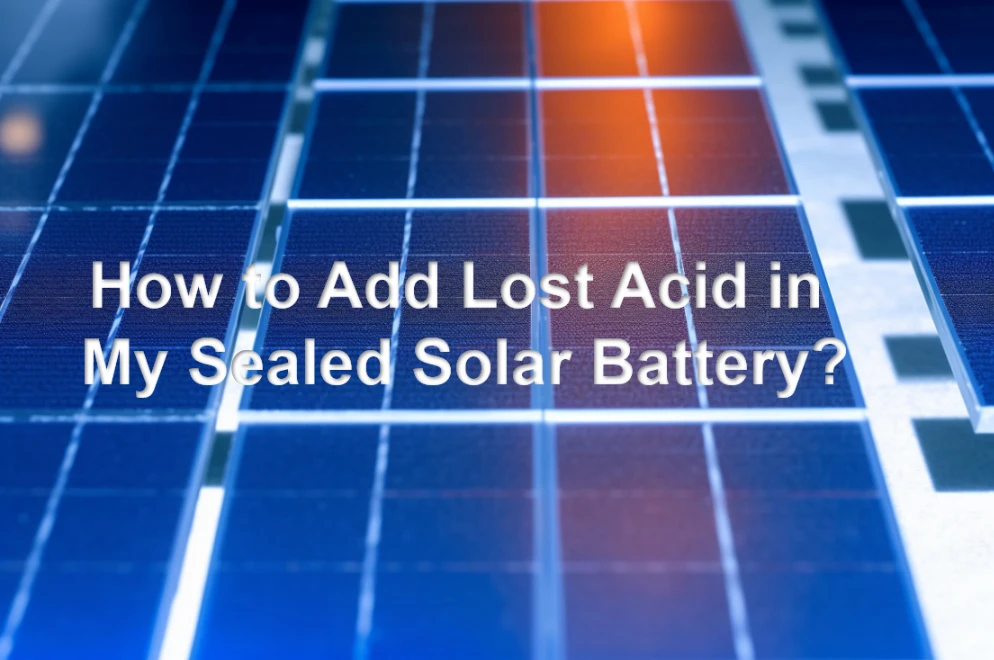
Introduction
Sealed solar batteries are designed with the purpose of saving energy for later use. With age, such batteries tend to lose acid, which can impair their performance and lifespan. We’ll talk about signs and symptoms of acid loss, common causes, and recommended steps required wherein you should add lost acid to a sealed solar battery. Additionally, we will talk about the preventive measures to minimize acid loss, ensuring the longevity and efficiency of your solar battery.
Signs and Symptoms of Acid Loss in a Sealed Solar Battery
In this section, let us see some signs and symptoms that indicate the existence of acid loss in a sealed solar battery. These signs help you come to know whether to bust out or not on maintenance of your sealed solar battery. Some notable signs include:
1.Reduced Battery Performance:
If you do not get the same level of energy output as you used to get before, it shows that your battery already has more than energy concept and capacities. The reduced levels of acid in it affect the battery’s ability to hold charge efficiently.
2.Low Electrolyte Levels:
This often results in decreased electrolyte levels in a battery. The electrolyte is the medium for the chemical reaction going on in the battery, and low levels affect its overall functionality negatively.
3.Visible Corrosion:
As corrosion is a result of chemical reactions, less visible damage usually follows the loss of acid. Therefore, proper inspection, sealing using an approved sealant, and immediate application of anticancer are vital to halting the further deterioration of your sealed solar battery.
Common Causes of Acid Loss
Understanding the causes of acid loss makes it possible to prevent further damage to your sealed solar battery. There are a variety of factors that promote this ailment, such as:
●Evaporation:
The electrolyte present in a sealed solar battery can evaporate over time, resulting in acid loss. Elevated temperatures, inadequate ventilation, and extended loss of use accelerate the evaporation process.
●Improper Charging/Discharging:
Inadequate charging or discharging practices also lead to acid loss. If a solar battery gets chemically imbalanced caused by consistently getting undercharged or overcharged, it begins slowly degrading the acid within the battery.
Step-by-Step Process for Adding Lost Acid
As discussed above, we understand the signs, symptoms, and causes of lost acid in sealed solar batteries. Now, let’s move to a step-by-step process of adding lost acid if you discover some acidic leakage from your battery:
1.Safety First:
Before handling the battery, ensure you are doing so with personal protective equipments (gloves and safety glasses) to avoid any contact with acid or electrolyte in case something goes wrong.
2.Prepare Battery:
Take off the sealed solar battery from its power source, i.e. the solar power system. Carefully clean any dirt or corrosion at the terminals of the battery.
3.Check Electrolyte Levels:
Using either a hydrometer or a battery tester, check electrolyte levels in each cell of the battery. To conclude, if they are under the recommended range, then it means there is an acid loss in the battery.
4.Adding Distilled Water:
Adding distilled water provides security to the electrolyte level; however, it is vital to add distilled water instead of tap water since contaminants or impurities can enter the battery using tap water.
5.Add Acid:
After water, you need to add battery-grade sulfuric acid to restore the normal acid concentration. Maintain the manufacturer’s instructions and guidelines with regard to the right ratio of acid to water.
6.Mix Up and Reharge:
Add an equal amount of both acids to a clean jar, gently mix them up and place it in the battery cells. Once added to the cells, disconnect the batteries from the solar power system and let them recharge fully.
Preventive Measures to Minimize Acid Loss
Minimizing the loss of acid from your sealed solar battery requires the consideration of preventive measures as outlined earlier. To ensure the continued performance of your sealed solar battery, consider the following:
1.Proper Charging:
Follow the recommended procedure for charging provided by the battery manufacturer. Avoid undercharging or overcharging the battery. Overloading the battery continuously will accelerate the erosion of the acid and hence reduce its performance.
2.Regular Maintenance:
Perform regular inspections and maintenance of the sealed solar battery. Check electrolyte levels, clean terminals, and ensure proper ventilation to avoid evaporation and corrosion.
3.Track Electrolyte Levels:
Look for signs of electrolyte level issues and maintain below the recommended ranges, according to the manufacturer. If frequently found problematic, look into the situation urgently since there are underlying reasons behind this occurrence.
4.Protect From Extreme Temperatures:
Extreme temperatures accelerate the loss of acids and inflict encumbrances on the battery’s performance. Store your battery at room temperature but not closer to direct sunlight radiation and needless fluctuations of extreme temperatures.
Conclusion
Doing things properly is always associated with higher performance and longer working lifespan, especially when it comes to taking care of your sealed solar battery nicely. Knowing the implications and symptoms of losing acid, common causes, and processes involved in adding the lost acid can be applied well in assuring that your sealed battery works optimally once more. Application of effective preventive procedures such as proper charging, regular maintenance, and observation of electrolyte levels will substantially minimize potential cases of loss of acids, thus allowing your sealed battery to sustain or even extend its lifetime. Surprisingly, checklists like these implemented regularly could allow reliable and efficient solar power for years to come.



